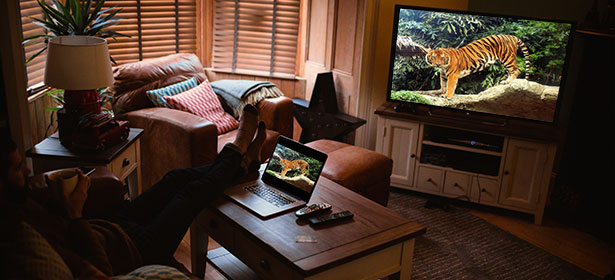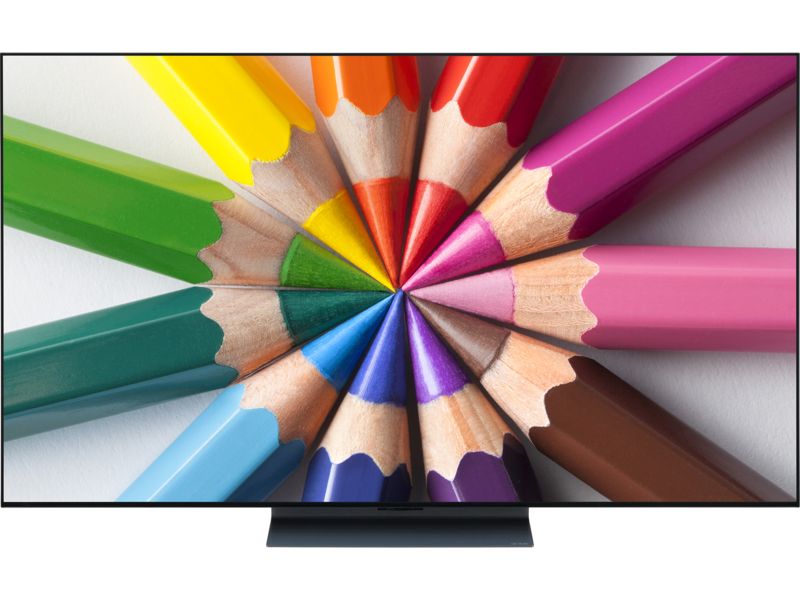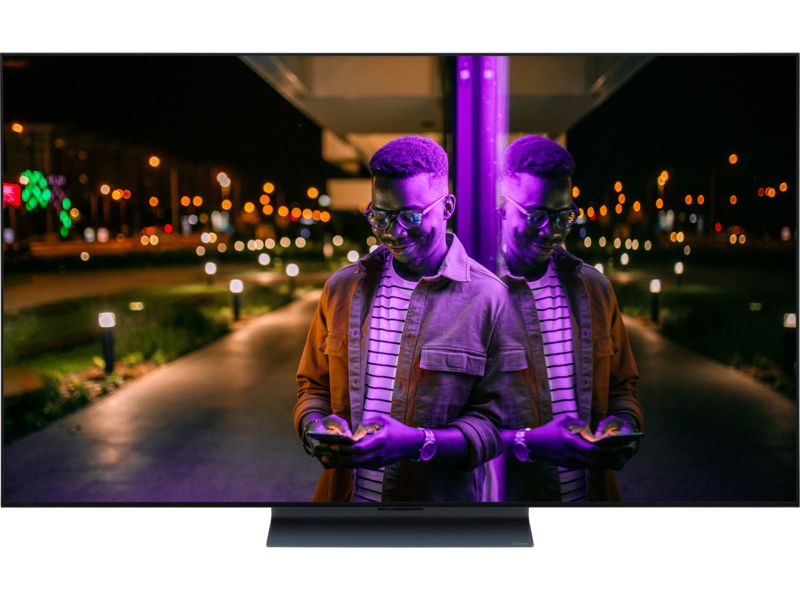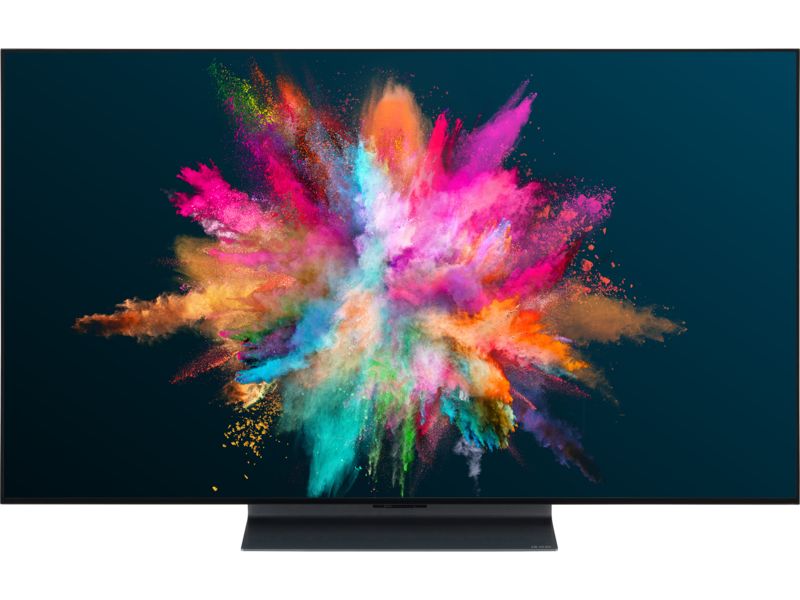By clicking a retailer link you consent to third party cookies that track your onward journey. If you make a purchase, Which? will receive an affiliate commission which supports our mission to be the UK's consumer champion.
How to connect a laptop or MacBook to a TV

A laptop with plenty of hard-drive space is perfect for storing all your photos and videos – but when it comes to viewing them, you can't beat a big, high-resolution TV screen. We'll show you how to connect the two.
These days, nearly every TV has wi-fi, which makes connecting a laptop easy. Even if your TV isn't as smart as the latest sets, connecting your laptop with a HDMI cable is simple, too.
As well as displaying content on your hard drive, your TV effectively becomes a monitor once a laptop is connected. You could browse the internet, play games and use software on a bigger screen.
Looking for a new computer? We reveal the best laptops for your money
How to connect a MacBook to your TV wirelessly
Apple uses AirPlay to link devices together to stream media from MacBooks.
To get your MacBook screen to display on your TV wirelessly, you'll also need an Apple TV device or a TV with Apple AirPlay 2.
- Click the AirPlay icon on the MacBook's menu bar.
- Select the Apple TV or TV you want to connect to from the dropdown menu.
- Select the Apple TV input on your TV to start displaying your MacBook's screen.
- Once connected, you can select either Mirror Built-in Display, which will set the resolution to the same as your MacBook; Mirror Apple TV, which use your TV's maximum resolution; or Use As Separate Display if you want to carry on using your MacBook screen and use the TV as an extra display.
Apple TVs aren't cheap (the latest model is £149), but you can achieve the same result with a £30 Chromecast. The connection process is the same as with a Windows laptop (see below).
How to connect a laptop to your TV wirelessly
Unless you have an older TV, you should be able to cast content to it from a Windows laptop or PC once they're on the same network. You can also use your TV as a display so your entire desktop appears on your TV, rather than just specific pieces of content.
How to cast from a Windows 11 laptop to a TV
- Right-click the content you want to cast.
- Select Cast to device from the menu.
- Select your TV from the options. You might see some other devices here too, such as games consoles, Blu-ray players and other computers.
How to display a Windows 11 laptop screen on a TV
- Press Windows + I on your keyboard and you'll get the settings menu. Then select Devices from the menu, followed by Bluetooth & other devices.
- Next, select Add Device followed by Wireless Display or Dock.
- Now you'll see a list of devices your PC can connect to, one of which should be your smart TV. Select it and you'll start seeing your PC on your TV screen.
Discover our favourite Windows laptops in our guide to the best Windows 11 laptops
How to connect a Windows 10 laptop to a TV
- Right-click the bottom-right corner of your screen and select Open action centre.
- In the action centre, select the box labelled Connect.
- The computer will search for wireless displays. Look for one that matches the brand and model number of your TV.
- Select your TV, once the computer has found it.
- The computer or TV may ask for a Pin to complete the connection. It will be displayed on one device and you'll need to enter it into the other.
Your TV should now display what's on your laptop screen. You can choose whether you want the TV to duplicate the screen (mirroring), or extend the display if you want to carry on using your laptop screen as well.
Tech tips you can trust - get our free Tech newsletter for advice, news, deals and stuff the manuals don’t tell you
How to connect a Chromebook to your TV
A Chromebook is a Google-powered laptop and it's easy to connect one to your TV wirelessly.
That is, as long as your TV has Chromecast (Google's streaming technology) built-in. Many TVs do and you can easily check.
- Open the Quick Settings menu by clicking the time in the bottom-right corner of the screen.
- Click Cast from the menu.
- Your Chromebook will then detect any TVs you have with Chromecast tech built in.
- Select your TV from the list and you'll see your Chromebook screen on your TV.
How to connect a laptop or MacBook to your TV with a Chromecast
If your TV doesn't support casting or screen mirroring, you can link it to your laptop with a Google Chromecast plugged into one of your TV's HDMI inputs.
You'll need to have the free Google Chrome browser installed on your computer for this to work.
- Open the Chrome browser and click the three-dot icon. You'll find it just below the X you use to close the window.
- Select Cast... from the dropdown menu.
- A separate box will pop up and start searching for your Chromecast.
- While it's searching, click the Cast to dropdown menu and select Cast tab to display your current Chrome tab, or Cast desktop to mirror your computer screen on your TV.
- Click the Chromecast you want to connect and you'll see your laptop display on your TV.
You can read more about Chromecast in our guide to the best streaming devices.
Best TV streamers to cast from a laptop or MacBook
If your TV doesn't have any sort of casting technology built in, then buying one of these streamers will give it that capability.
Apple TV
If you're looking to connect a MacBook to a TV doesn't support AirPlay, then an Apple TV is your best bet.
They're expensive, though, so we wouldn't recommend one just for this purpose – particularly when you can cast from specific software, such as Google Chrome tabs, onto a Chromecast.
However, if you want to the full desktop-sharing experience and don't want to be limited to Chrome tabs, then head to our Apple TV review to see if it's worth the £149.
Google Chromecast
If you're wanting to connect a Windows laptop to your TV, then a Chromecast will give you the most flexibility. You'll have the option to cast your Windows desktop to your TV, choose a Chrome tab or cast from specific software.
You can choose an HD or 4K Chromecast,. This decision won't impact your casting much, but consider whether you'd also like to use the Chromecast to stream 4K content onto your TV from apps such as Netflix and Prime Video. If you don't, then choose the cheaper HD model.
Check our reviews to see which one will suit you best:
How to connect your Chromebook, laptop or MacBook to your TV using a cable
If your TV doesn't support wireless screen mirroring, you can still connect your laptop or MacBook the old-fashioned way.
How you do it will depend on the ports on your TV and laptop. Ideally, use an HDMI cable. This transmits both video and sound, which is handy if you're watching a video or want to listen to music through your TV.
Some older laptops don't have HDMI outputs. If yours doesn't, look for a VGA port instead. Unfortunately, VGA only transmits video, and newer TVs don't have VGA inputs.
Don't miss the best home printers



